Shep Hyken's Blog, page 90
February 12, 2021
Guest Post: Top 5 Ways to Support Your Customers in 2021
This week we feature an article from Veronika Filipkova, a professional content editor and Chief Customer Officer at SupportYourApp. She shares different channels and strategies for creating the most convenient customer support experience for your customers.
According to Deloitte’s 2019 Global Call Center Survey, customer service topped the agenda for most firms. 85% of respondents believed that the customer experience was vital to success. 78% of participants believed that improving customer service came a close second.
The pandemic made these elements even more crucial in 2020 and will continue to do so into 2021. Firms today should focus on providing top-notch service. More importantly, however, they must provide it in a manner convenient for their clients.
In this article, we’ll look at ways to support your customers through the customer support channels most important to them.
Customer Support Channels to Develop in 2021One Central Support Hub 24/7The key going into 2021 is to take a lesson from effective project management – provide one point of contact for your clients. By doing so, you simplify matters for the client. You’ll also reduce the chances of the client experiencing two of their biggest pet peeves:
Having to explain the situation all over again to a new consultantNot getting through to someone who can answer their query47% of companies outsource their call center operations to solve capacity issues. Whether run in-house or through a third-party provider, firms benefit from one point of contact by:
Clients receiving a consistent experience no matter which channel they useBeing seen as a helpful and professional organizationStreamlining their internal operations and improving productivityAllowing their sales and creative teams to focus on generating more businessInstant MessagingWith over 2 billion active users, WhatsApp dominates as the most popular messaging app. Facebook and We Chat come in close behind with 1,300 and 1,206 billion users respectively.
Instant messaging is popular because it’s immediate and inexpensive. Consequently, it rises as one of the top ways to support your customers going into 2021.
Social MediaFor the purposes of this article, we’ll count messaging apps as separate from social media. While clients often reach out using the apps on sites like Facebook and Instagram, where we’re more focused on comments and reviews that they leave.
Going into 2021, consumers want to simplify their lives. Over the last few years, we’ve seen social media platforms evolve into more than simply a tool for communication. Clients now use the platforms as a more rounded search and buying tool as well.
Social media 2.0 is fast becoming one of the best ways to support your customers. It provides consumers with a useful service tool that resides where they spend much of their time online. Instead of having to look up phone numbers or fill in contact forms, they may simply make a comment on the company’s page.
It’s a frightening prospect for companies. Do you allow comments that might not show your company in the best possible light? Scary as it might be, it’s best to allow clients to have their say. How you deal with their comments says much about your company and its attitude toward customer service.
You might not be able to save the relationship with a particularly negative poster. You can, however, demonstrate what your company is truly about to others reading your response. If you’re getting service delivery right most of the time, you’ll no doubt have some fans that’ll stand up for you.
Video ChatConsider incorporating video chat if you have not already done so. According to an IPSOS survey in May 2020, 57% of Americans regularly used video chat. 38% of respondents had never used this channel before the outbreak, but 85% could see themselves using video chat going forward.
With people becoming increasingly aware of cybersecurity, being able to see a consultant at the other end of the line is reassuring. The company benefits as well as agents are better able to pick up on the non-verbal cues that account for 55% of communication effectiveness.
Self-Help ChannelsThe final trend for 2021 is the rise of the self-help channel. Firms should provide robust support for clients who want to find the answers without calling the contact hub. This starts with providing clear and clean instructions and a well-organized, up-to-date knowledge-base.
It extends to providing simple automated chat options to answer easy, much-repeated questions. Provide those that want to find the answers themselves the tools to so. Back this service up with flawless in-person support as well and you’ll maximize customer satisfaction.
Final Notes2021 won’t bring huge surprises in the customer service arena. 2020 was a rocky road, and people want to return to something akin to normal. Firms must, however, increase their support of customers via the channels convenient to the client.
A mix of a conventional call center, instant messaging, social media, self-help, and video chat contains all the ingredients for client support success in the new year.
Veronika Filipkova is a professional content editor and CCO at SupportYourApp. While working at SupportYourApp, she got to know everything about customer support and likes to share her knowledge with everyone else. Veronika is passionate about business, customers and has published many articles in this area.
F
 or more articles from Shep Hyken and his guest contributors go to customerserviceblog.com.
or more articles from Shep Hyken and his guest contributors go to customerserviceblog.com.
Read Shep’s latest Forbes article: Losing Customers? Here’s Why–And What To Do About It
The post Guest Post: Top 5 Ways to Support Your Customers in 2021 appeared first on Shep Hyken.
February 10, 2021
The Show Starts When the Phone Rings
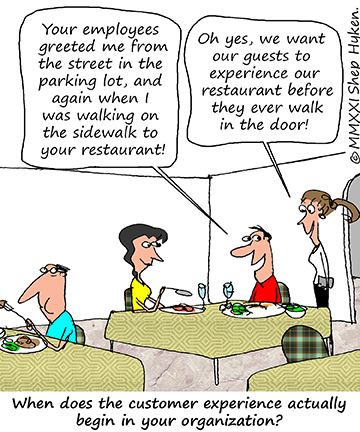 You may or may not know that I’m a magician. Some of you may know that I’m also a musician. But today I want to talk about being a magician.
You may or may not know that I’m a magician. Some of you may know that I’m also a musician. But today I want to talk about being a magician.
Growing up throughout high school and college I performed at parties, corporate events and comedy clubs. That experience in show business gave me the stage chops to start my business as a professional speaker.
I share this background to give you some context. Many of my friends are professional entertainers. A friend I’ve known for years is Jeff McBride, an amazing magician who performs throughout the world and resides in Las Vegas.
I was reading an article by Jeff in a magic magazine. He was writing about the business of a magic show, but his concept applies to business in general. His comment was, “The show starts when the phone rings.” He was referring to clients who call him for private engagements.
The point he was making was that the customer experience begins the moment the customer connects with you, not when they see you on stage or in person. The way the phone is answered is really your opening act, and the manner in which you conduct yourself from that point forward, all the way up to taking the stage, is part of the overall show experience for the client. I’ll also add that every interaction that comes after the performance on stage is part of the show. We can call that the encore.
It’s the same in business. Our customers may find us as the result of a Google search or a recommendation from a friend or colleague. They land on our website. They look around and research. They may call us or visit us. At some point, they move from thinking of doing business with us to actually buying whatever we sell. Depending on what we sell, whether B2B or B2C, the buying cycle may take more than one visit. It could take weeks or months … maybe even longer. So, when does the customer start making the decision to buy? Long before they actually make the purchase. It happens between the moment the customer thinks of you and the time they actually buy. And, it’s probably much earlier in the process than you think.
Everything that happens leading up to the sale is part of the customer experience. And, that includes customer service. Most people think service happens after the sale. The reality is that every interaction leading up to and after the sale is part of service and experience. That first time the customer lands on your website or makes a phone call – that’s the opening act. From that point, the show has started. In business, the show never ends. There’s the follow-up, customer support and repeat business. For some, this is common sense, so consider this a reminder. For those who haven’t thought this way, this could be an epiphany.
So, here’s to strong opening acts, standing ovations and encores that get your customers to come back again and again!
Shep Hyken is a customer service expert, keynote speaker, and New York Times bestselling business author. For information, contact 314-692-2200 or www.hyken.com. For information on The Customer Focus customer service training programs, go to www.thecustomerfocus.com. Follow on Twitter: @Hyken
customer service training programs, go to www.thecustomerfocus.com. Follow on Twitter: @Hyken
(Copyright © MMXXI, Shep Hyken)
The post The Show Starts When the Phone Rings appeared first on Shep Hyken.
February 9, 2021
Amazing Business Radio: Gabe Larsen
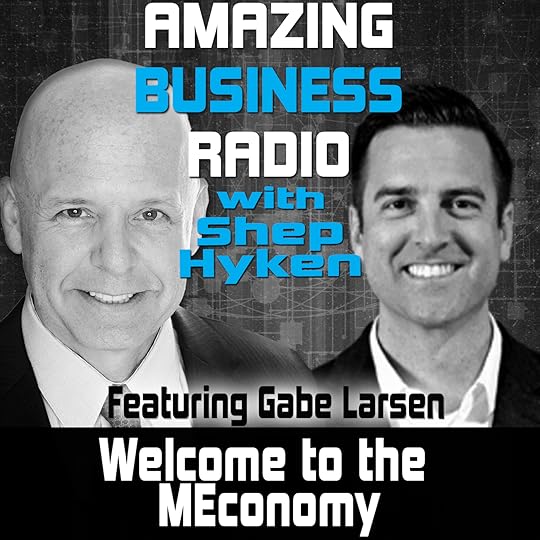 Welcome to the MEconomyCreating the Most Convenient Experience in Customer Support
Welcome to the MEconomyCreating the Most Convenient Experience in Customer SupportShep Hyken interviews Gabe Larsen, VP of Marketing for Kustomer. They discuss the importance of creating a convenient CX and the impact an omnichannel platform has on the way businesses interact with their customers.







 Top Takeaways:The MEconomy is about giving the customer what they want, when they want it, how they want it, with little to no effort. That’s convenience!A perfect omnichannel experience allows a customer to start a support conversation through one channel and finish the same conversation in another without having to repeat information.Kustomer has found that 77% of customers expect their problem to be resolved immediately, placing an emphasis on ‘real-time’ customer service strategies.Personalization has only grown more important throughout the COVID-19 pandemic. Customers are used to it, and it’s not going away.Chatbots have an important role to play. The problem with a lot of today’s chatbots is that they’re not able to connect to a CRM system.It’s crucial in today’s world to position your company in a way that ties your CRM to your channels of communication in order to provide great customer service.Incorporating self-service, real-time responses, personalization, and communication channel-of-choice can ultimately lead to a convenient experience for customers.Quotes:
Top Takeaways:The MEconomy is about giving the customer what they want, when they want it, how they want it, with little to no effort. That’s convenience!A perfect omnichannel experience allows a customer to start a support conversation through one channel and finish the same conversation in another without having to repeat information.Kustomer has found that 77% of customers expect their problem to be resolved immediately, placing an emphasis on ‘real-time’ customer service strategies.Personalization has only grown more important throughout the COVID-19 pandemic. Customers are used to it, and it’s not going away.Chatbots have an important role to play. The problem with a lot of today’s chatbots is that they’re not able to connect to a CRM system.It’s crucial in today’s world to position your company in a way that ties your CRM to your channels of communication in order to provide great customer service.Incorporating self-service, real-time responses, personalization, and communication channel-of-choice can ultimately lead to a convenient experience for customers.Quotes:“The five pillars that define a MEconomy include self-service, real-time, personalization, channel-of-choice, and low effort.”
“Wherever your customers are, is where you need to be. And to make that communication simple, omnichannel is the way to go.”
“When looking at how to measure the customer journey, you have to look at the convenience in every step your customer takes.”
“Today’s customers are switching like crazy. If they experience service that isn’t convenient, they will take their business elsewhere.”
About:Gabe Larsen currently leads Kustomer’s worldwide marketing efforts, including advertising, brand, communications, demand, and digital. Prior to joining Kustomer, Gabe was the VP of Marketing for XANT where he helped create the sales acceleration category and grow the company to nearly one-hundred million in revenue.
Shep Hyken is a customer service and experience expert, New York Times bestselling author, award-winning keynote speaker, and your host of Amazing Business Radio.
This episode of Amazing Business Radio with Shep Hyken answers the following questions … and more:
What is an omnichannel platform?What is the difference between multichannel and omnichannel?How to create a convenient customer service experience?How to create a personalized customer service experience?How to manage multiple channels of communication?The post Amazing Business Radio: Gabe Larsen appeared first on Shep Hyken.
February 8, 2021
5 Top Customer Service Articles For the Week of February 8, 2021
Each week I read a number of customer service and customer experience articles from various resources. Here are my top five picks from last week. I have added my comment about each article and would like to hear what you think too.
Make Every Day Valentine’s Day by Showing Love and Empathy to Customers by Janelle Estes
(CMSWire) Valentine’s Day is approaching. And while businesses won’t be sending their customers chocolates and flowers, there’s still a lot they can do to show how much they care — every day of the year.
My Comment: With Valentine’s Day next Sunday, I thought this is an appropriate article to start this week’s Top Five roundup. I’m sure there will be many more Valentine-themed articles this week, so here’s my take. In our personal lives, Valentine’s Day is our opportunity to express love and appreciation to the people you care about. And even though it happens once a year, that doesn’t mean we shouldn’t express love the other 364 days. It’s the same in business. Love (in the metaphorical sense) and appreciate your customers year-round.
Key 2020 holiday shopping takeaways: It’s imperative to adapt as customer expectations evolve by Tara Bartley and Ashitha Bhanu
(Retail Customer Experience) Tara Bartley, senior manager, industry marketing, and Ashitha Bhanu, industry marketing, Akamai, share Akamai data relating to the most recent holiday shopping season and the top trends in play.
My Comment: 2020 is behind us, but the lessons we learned, as a result, should not be forgotten. Here is a good list of some of the key takeaways. Our customers’ expectations (in all types of businesses, not just retail) have changed. Pay extra attention to number two on the list, which is to create the most convenient experience possible, which has become one of the most competitive differentiators in all types of businesses and industries.
Next generation is the new generation in customer experience by Carlos Lopez-Abadia
(Fast Company) As we witnessed in the 2009 downturn, if companies react quickly and organize themselves well, there are many opportunities to be gained from this crisis.
My Comment: The pandemic pushed us into the future without us even knowing it was happening. It proved to be, for many businesses, an accelerator of new processes and adaption of technology/innovation. This article reminds us that with the right mindset and strategy, we are looking at an opportunity.
4 Ways Customer Experience Will Change in 2021 by Inge De Bleecker
(CMSWire) Predicting what will happen in 2021 seems to be a fool’s errand given that the pandemic is still raging — but I’m going to give it a shot.
My Comment: How will customer experience change in the near future? This article includes four trends. One important one covered in the article is that accessibility is going to move into the digital world as brands are able to add code to their websites to be more inclusive for customers with disabilities. Also included are self-service chatbots, a contactless experience, and codeless programming that makes it easy for companies to automate and keep up with fast changes needed to manage their customers’ expectations.
10 B2B Customer Experience Myths & How to Improve Your CX Maturity by Lynn Hunsaker
(CustomerThink) Before you accept a claim about B2B customer experience maturity, check the employment history of the speaker, the source’s vested interest, and these facts.
My Comment: You know how I love lists, and Lynn Hunsaker has given us a great one to close out this week’s roundup. With so many articles that are focused on retail and consumers, it’s nice to get a deep dive on the B2B side.
 Shep Hyken is a customer service expert, professional speaker and New York Times bestselling business author. For information on The Customer Focus
Shep Hyken is a customer service expert, professional speaker and New York Times bestselling business author. For information on The Customer Focus customer service training programs go to www.TheCustomerFocus.com. Follow on Twitter: @Hyken
customer service training programs go to www.TheCustomerFocus.com. Follow on Twitter: @Hyken
The post 5 Top Customer Service Articles For the Week of February 8, 2021 appeared first on Shep Hyken.
February 5, 2021
Guest Post: 5 Tips to Improve a Bad Customer Experience
This week we feature an article from Skylar Ross, contributor at Raincatcher. He writes about how to turn negative customer service interactions into positive experiences.
You would more than likely prefer if all of your customer interactions and transactions were completed smoothly and resulted in positive experiences for the customer and your business. However, you also are more than likely aware that this ‘perfection’ is highly unlikely and not the normal product of human behavior. The truth is that no matter how considerate, accurate, and helpful you or your business are towards your customers, problems will always arise. A few customer service problems during every quarter are not a cause to worry. In fact, your business’s reputation will be determined less by the initial problem, and more by how you choose to handle this problem and appease the customer’s worries and concerns.
The following list discusses five tips every business can implement into their customer service procedures. These tips will allow you to transform a bad customer experience into a positive one.
Talk With Your TeamIt is highly probable that negative feedback your business receives from a customer will be directed at a particular agent or employee. After receiving this information, it is important you do not respond to the customer before talking with the particular agent mentioned. You will want to hear things from their perspective to better gather information on what happened during their exchange with the customer. There are two sides to every story.
In these situations, it may also be helpful to gather other agents and employees to talk about how you should go about handling the negative feedback. Collaboration will allow you to develop a strategy to handle upset customers without first issuing blame onto your agents or employees.
Send Free GiftsThis procedure is not appropriate in all discourses or industries. However, if you do work in an industry where providing free services or gifts is appropriate then this can be a highly effective way to handle unhappy customers. B2B companies should reach out first before sending gifts to customers of another business. It is also important that you keep track of who you have sent free gifts to. After all, you don’t want to keep rewarding the same unruly customer over and over for their inappropriate behavior.
Apologize In PersonSome customers may care less about free gifts and more about a sincere and genuine apology. After you anticipate what your customer is looking for in terms of an apology, you should look to schedule an in-person meeting where you can explain your feelings towards the situation in person. Traveling to a location that is convenient for the customer is a great strategy, especially in a B2B relationship.
During the in-person meeting, it may be easier to develop a personal relationship and compromise on a solution. After all, when people talk together in person it is substantially easier to understand where each other is coming from.
Involve a SuperiorWhile you probably don’t want your superior to be informed of every little customer complaint, in some situations it may be necessary to involve them. They can normally be extremely helpful when you are dealing with major mistakes and problems your agents or employees have caused. Your executives can also meet with the customer or their executives to develop a solution and plan for future interactions between your two parties. At the very least an apology from the superior of a company shows that you are committed to achieving great relationships with your customers.
Prevent Future IssuesJust like the best defense is a good offense. The best way to handle negative customer feedback is to prevent these situations from arising in the first place. Communication is one of the most effective ways to prevent negative customer relationships from forming. Make sure that your agents and company are well aware of what the customer wants or needs, and vice versa make sure the customer is well aware of what services or work you are promising to provide.
Summary: Accountability and CommunicationEvery negative customer interaction can be attributed to a flaw in accountability or communication. The tips previously discussed will help you develop a better plan to handle adverse customer relations. However, you should also constantly be looking to improve how accountable and communicative your agents and employees are towards your customers.
Skylar Ross is a contributor at Raincatcher and a blogger. His contributing site, Raincatcher, provides useful tools and advice for business owners such as a business valuation calculator , exit planning strategies, and guides to selling your business.
F
 or more articles from Shep Hyken and his guest contributors go to customerserviceblog.com.
or more articles from Shep Hyken and his guest contributors go to customerserviceblog.com.
Read Shep’s latest Forbes article: Conscious Capitalism Gets Creative in COVID-19
The post Guest Post: 5 Tips to Improve a Bad Customer Experience appeared first on Shep Hyken.
February 3, 2021
The Problem Isn’t the Employee, It’s the System
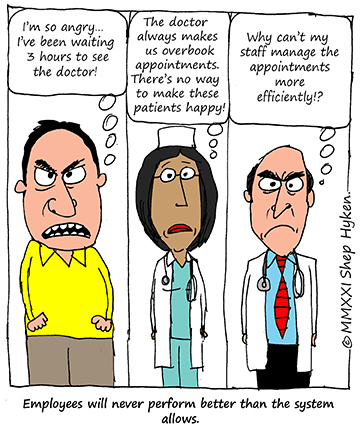 Here’s a true story shared by a friend and speaking colleague. The short version is that there is a doctor, who is probably a good doctor. But he’s a terrible boss.
Here’s a true story shared by a friend and speaking colleague. The short version is that there is a doctor, who is probably a good doctor. But he’s a terrible boss.
When a patient – as in his customer – complains about something, he listens and then goes back to his employees, and in a knee-jerk reaction, he berates and punishes them by taking away their incentives. You can only imagine what that does to the morale of the team. And what happens next? The employees quit, which is understandable.
There are plenty of employee surveys that point to the number one reason people quit their jobs. Many people think it’s money, but it is actually due to a lack of appreciation from their boss.
It’s okay for a boss to be hard to work for. But the boss who has high expectations can still show appreciation and support employees. Receiving a complaint from a customer doesn’t mean it’s time to turn on your employees. On the contrary, it’s the time to sit down and find out why it happened. And here’s the interesting part. It’s usually not the employee’s fault. And it’s not the customer’s fault either. Most often, it’s the process.
Here’s a simple example. Let’s make the assumption that the doctor has hired employees who are friendly and competent. The doc is running behind and patients in the reception area are becoming impatient. One of them becomes angry and complains. This doctor doesn’t understand the real reason behind the delays, which are due to overbooking. Instead, he thinks the delays are due to poor management by the front desk personnel. Yet it is the doctor who insists they book – actually overbook – patients back-to-back.
When there is a problem, even if it appears to be the employee’s fault, you need to understand why it happened. If it’s related to an employee’s attitude, that is a coachable moment. Managed the right way you’ll get the employee back on track or you’ll quickly learn he or she needs to go to a different position – or another job in another company.
If it’s because the employee didn’t know what to do, then it’s simply a function of training, which is tied to your system or process. If employees aren’t properly onboarded and trained for their jobs, you can’t expect them to perform at their best.
Or maybe it’s just a bad process or system that needs to be fixed. This is something that needs to be discussed, managed and corrected. And here’s the interesting part of all of this. The late Dr. W. Edwards Deming, renowned professor, statistician and author, stated that 94% of problems are the fault of the system. People can’t perform better than the system allows.
So, in most cases, it’s not the people. It’s the system or process. If you work together with your people, you can focus your efforts on fixing what’s broken.
Shep Hyken is a customer service expert, keynote speaker, and New York Times bestselling business author. For information, contact 314-692-2200 or www.hyken.com. For information on The Customer Focus customer service training programs, go to www.thecustomerfocus.com. Follow on Twitter: @Hyken
customer service training programs, go to www.thecustomerfocus.com. Follow on Twitter: @Hyken
(Copyright © MMXXI, Shep Hyken)
The post The Problem Isn’t the Employee, It’s the System appeared first on Shep Hyken.
February 2, 2021
Amazing Business Radio: Scott Harris
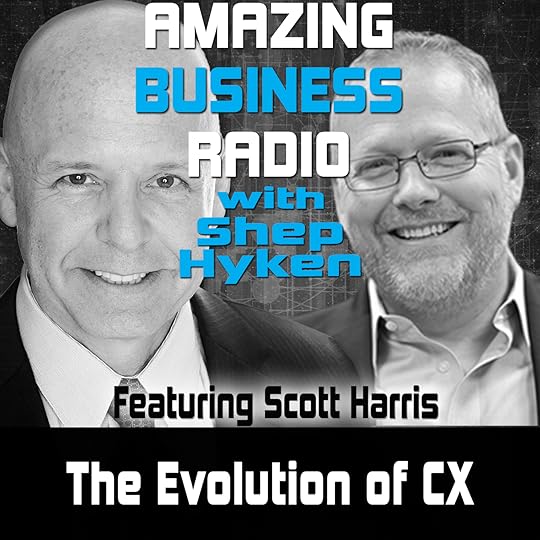 The Evolution of CXPerfecting Your Customer Experience in Real-Time
The Evolution of CXPerfecting Your Customer Experience in Real-TimeShep Hyken interviews Scott Harris, CEO and Founder of Experience.com, with a special guest appearance by Chief Experience Officer of Experience.com, Brittany Hodak. They discuss the power of collecting immediate customer feedback to improve the customer experience in real-time.







 Top Takeaways:Scott Harris defines creating ‘wow’ as helping your customers always get more out of CX and going over and above in delivering for your customers.If you wait until the end of an interaction to survey your customers, you are essentially surveying the memory of an experience.CX for years has been about collecting and analyzing data to make great business decisions. Now that same data can be used as a behavioral driver powering better customer experiences in the immediate moment.Legacy CX is telling your customers that their feedback matters because you will be using their feedback to shape the experience for future customers.CX feedback in real-time empowers the brand to fix the experience immediately for customers that report problems, which in turn creates confidence and trust in your brand and the experience.We’re now seeing a paradigm shift in CX that empowers not only the customer but also the employees to shape the experience.Customers who leave positive reviews in a survey allows for opportunities to automatically send follow-up messages and offers for these happy customers to join your rewards program, for example.Even small businesses can take the concept of sending immediate surveys to help create a better experience for their customers. Not every company needs data-driven software to fix customer issues and improve CX overall.In the enterprise world, there is ROI everywhere and with billions of dollars lost from poor customer service every year, companies cannot afford to use the old paradigm of CX anymore.Companies are evolving to systems, processes and connectivity that allows them to interact with their customers and improve CX in real-time.Quotes:
Top Takeaways:Scott Harris defines creating ‘wow’ as helping your customers always get more out of CX and going over and above in delivering for your customers.If you wait until the end of an interaction to survey your customers, you are essentially surveying the memory of an experience.CX for years has been about collecting and analyzing data to make great business decisions. Now that same data can be used as a behavioral driver powering better customer experiences in the immediate moment.Legacy CX is telling your customers that their feedback matters because you will be using their feedback to shape the experience for future customers.CX feedback in real-time empowers the brand to fix the experience immediately for customers that report problems, which in turn creates confidence and trust in your brand and the experience.We’re now seeing a paradigm shift in CX that empowers not only the customer but also the employees to shape the experience.Customers who leave positive reviews in a survey allows for opportunities to automatically send follow-up messages and offers for these happy customers to join your rewards program, for example.Even small businesses can take the concept of sending immediate surveys to help create a better experience for their customers. Not every company needs data-driven software to fix customer issues and improve CX overall.In the enterprise world, there is ROI everywhere and with billions of dollars lost from poor customer service every year, companies cannot afford to use the old paradigm of CX anymore.Companies are evolving to systems, processes and connectivity that allows them to interact with their customers and improve CX in real-time.Quotes:“Legacy CX is asking your customers for their feedback so that you can try to do better for customers in the future. What if that feedback could make you better right now?”
“You don’t want to survey the memory of a customer’s experience. You want to survey the experience in real-time.”
“Experiences are happening right now, and companies are evolving to systems and processes that allow them to improve CX in real-time.”
About:Scott Harris is the CEO and founder of Experience.com, a game-changing Experience Management Platform (XMP). Harris is also the author of CX 2.0: Create WOW Customer Experiences, which outlines the future of real-time experience management, released in 2020.
Shep Hyken is a customer service and experience expert, New York Times bestselling author, award-winning keynote speaker, and your host of Amazing Business Radio.
This episode of Amazing Business Radio with Shep Hyken answers the following questions … and more:
What is the future of CX?How to create an amazing customer experience?How can CX be automated?How to collect customer feedback?How can technology help improve the customer experience?The post Amazing Business Radio: Scott Harris appeared first on Shep Hyken.
February 1, 2021
5 Top Customer Service Articles For the Week of February 1, 2021
Each week I read a number of customer service and customer experience articles from various resources. Here are my top five picks from last week. I have added my comment about each article and would like to hear what you think too.
Improve Your Customer Outcomes With 5 Customer Service Best Practices from Leading Consumer Shipping Brand FedEx by Veronica Krieg
(Sharpen) Let’s dive in on five of the best practices FedEx uses to deliver top-notch customer service.
My Comment: I always enjoy articles that teach lessons from iconic companies, and in this case the company is FedEx. There are five great ideas here, and at least one, if not all can work for just about any type of company.
Why Saying ‘No’ Helps Build Great Customer Experiences by Zach Lipson
(TotalRetail) If a customer or prospect is saying they want a particular feature or change to the product, should we just fulfill that request in pursuit of retention or growth?
My Comment: The customer is NOT always right, but they are always the customer. I’ve preached this for years. So, what happens when they are wrong? What happens when you have to say, “No.” This article addresses why saying “No” may not be so bad. That said, I believe there are ways to say “no” without saying “no.” That’s a topic for another day. In the meantime, read this.
9 Ways to Boost Customer Experience and Online Engagement by Shane Phair
(TotalRetail) These top takeaways will show retailers, many of whom are at least partly online today, where to focus in 2021 so they can optimize their websites and apps, improve customer experience, and drive conversion optimization rates.
My Comment: As customers move to accepting the digital experience – and expecting the companies and brands they do business with to provide a good experience – it’s important to understand what customers want. There are some great ideas in this article that lists nine ways to create a better CX and promote more engagement.
Deep Dive: How Rewards Programs Can Fuel Customer Spending by PYMNTS
(PYMNTS) Starbucks has a winning recipe when it comes to taking care of its customers. The Seattle-based coffee giant’s loyalty program has 19 million active members that account for 48 percent of its annual revenue.
My Comment: Depending on the type of business you are in, a rewards program can be, well, very rewarding – to both the customer and the company. While the example in this article is Starbucks, it’s interesting to think how this could apply to other types of businesses. You don’t have to use all the ideas. Just one – and that’s the one that could make the difference for you.
Price is ripe: Study finds increase in menu prices means decrease in restaurant ratings by Olin Business School
(Washington University in St. Louis) Businesses beware: A price increase for carryout or delivery food means an increase in negative reviews — and a downturn in restaurant reputation, if not demand.
My Comment: I found this article to be fascinating. I’m not sure I agree with the findings, but the idea is that raising prices in a restaurant, even as much as 1% can negatively impact the average ratings by 3-5%. It made me wonder about other industries. My research indicates that the right experience and value proposition makes price less relevant. It’s a quick read with some interesting research.
BONUSESA 6-Step Process to Creating a Superior Customer Experience From the Inside Out by B2B International
(B2B International) Our recent research shows that the majority of B2B business leaders feel that understanding their customers is a focus area for improvement throughout 2021 and beyond.
My Comment: Not long ago B2B International interviewed me on their B2B Insights Podcast about customer service and CX. They did a great job putting this into a short article and an info-graphic. Check it out!
The 2021 Customer Experience Outlook by Kerry Bodine
(Kerry Bodine) To bolster our optimism I reached out to some of my favorite CX thought leaders and friends to see what they were thinking about at the start of this new year.
My Comment: What happens when eight customer service and CX experts get together and share information? You get an amazing report. Our friend Kerry Bodine pulled it all together. You’ll have to download it, and it won’t cost you a thing.
 Shep Hyken is a customer service expert, professional speaker and New York Times bestselling business author. For information on The Customer Focus
Shep Hyken is a customer service expert, professional speaker and New York Times bestselling business author. For information on The Customer Focus customer service training programs go to www.TheCustomerFocus.com. Follow on Twitter: @Hyken
customer service training programs go to www.TheCustomerFocus.com. Follow on Twitter: @Hyken
The post 5 Top Customer Service Articles For the Week of February 1, 2021 appeared first on Shep Hyken.
January 29, 2021
Guest Post: 5 Contact Center Best Practices That Make Clients Happier
This week we feature an article from babelforce, a global cloud communications platform. They provide some tips and tricks to set your business up for success in the contact center.
Daunting as it may appear, keeping your customers happy is an attainable goal — when you put your mind to it. Following best practices and applying hacks has proven fruitful for a lot of contact centers. You can do the same and improve your customers’ experience.
This shortlist of contact center best practice hacks should set you up for success in the pursuit of customer service excellence.
1. Get to know the customer personally.You wouldn’t have a contact center if you had no customers to start with. Keeping your customer agents aware of this fact goes a long way to making customer experiences pleasant. While it’s near impossible to know every customer the way you know your peers, you can use call center software to bridge the gap.
IVR systems make it possible to collect information about a client when they call. It can also assign their session to an agent capable of assisting them. The outcome can be something as simple as routing their call to an agent that speaks in their preferred language. Such a gesture goes a long way toward retaining customers.
2. Follow up on your calls.Roughly speaking, about 50% of the customers you serve have any hope that their concerns will be addressed. To improve these odds, you ought to follow up on the calls with updates on the issues dear to your customers.
Automated outbound calls are one way to turn the follow-up practice into a ritual. Not only will it improve the image your customers have about your company, but it also translates to fewer calls from customers. They often call doing follow-ups on their tickets.
3. Cultivate a continuous learning culture.Even with a knowledge base filled to the brim with product support cases, along with a killer script on their side, your agents’ effectiveness hinges on their knowledge of the product in more ways than we’d like to admit.
Refresher courses, seminars, and other product knowledge dissemination activities should be a staple of contact center work routines.
Yes, NLP and NLU have been shown to cut the product learning curve for agents and peak their effectiveness almost as soon as they get hired… but still, your customer will prefer learning about a product from a voice that sounds more in charge than in doubt of how a product works.
4. Adopt new tools quickly (IVR systems).We wouldn’t blame you for keeping the outdated call center equipment you’ve been using as long as it takes calls and keeps the contact center looking busy. ‘Productivity’, on the other hand, is an angle of busyness that most call centers miss.
With outdated tools costing your agents 75% of their call time doing manual research, we can say with certainty that the older your tools, the less productive your contact center is.
5. Invest in your agents.Happy agents set the tone for good customer experiences. No matter how well you end up automating with IVR systems, you will eventually need that good ol’ human touch. At least for now! That being the case, morale boosting and team building events should become the norm at your company. For a job that asks for a lot of listening, it lifts contact center staff to be listened to now and then.
That’s it… simple yet so effective as everything ought to be.
These five are by far the most actionable hacks you could apply to quickly improve your contact center.
In summary, keeping (and making) customers happy using a contact center requires deliberate effort. Making sure your agents are using the best equipment available for the job is one way to make their jobs easier. Them being happy is a contagious feeling that customers join in eventually. At the end of the day, the customer should be at the core of all your efforts like a cult.
Babelforce is a global cloud communications platform focused on No-Code integration and automation. It allows non-technical people to build even the most complex integrated processes for customer-facing teams, particularly in the call center.
F
 or more articles from Shep Hyken and his guest contributors go to customerserviceblog.com.
or more articles from Shep Hyken and his guest contributors go to customerserviceblog.com.
Read Shep’s latest Forbes article: Leaders, Here Are Five Stats You Know And Understand
The post Guest Post: 5 Contact Center Best Practices That Make Clients Happier appeared first on Shep Hyken.
January 27, 2021
Be a Goldfish
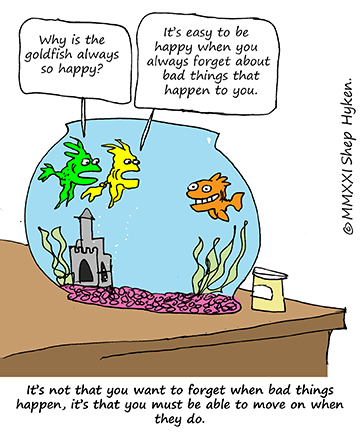 I was recently asked what three traits I think are most important for someone in customer service to have.
I was recently asked what three traits I think are most important for someone in customer service to have.
I’d like to broaden the topic to anyone dealing with someone else’s problem or question, be it a customer or another person inside the organization, also known as an inside customer. My response to the question was quick:
Empathy, which I have chosen as The Word of the Year. More than ever, our customers need to feel a connection.Good communications skills, which includes listening and also ties back to empathy. If you miscommunicate with customers, that could lead to them saying something like, “I don’t like doing business with them. They don’t understand me.” How many customers come back to a business that doesn’t understand them? (That’s a rhetorical question.)Resilience, which is what’s needed to put the problem you just handled behind you and move to the next situation with a clear and open mind.It’s the third one, resilience, that I want to cover today. This is the ability to move on and put anything negative that happened in the most recent interaction with a customer behind you – especially if it was negative or contentious. This isn’t easy. I recently interviewed Eric Williams, the chief marketing officer at CallMiner, who said that it could take a professional customer support agent up to 40 minutes to bounce back after a call in which the customer may have been angry, used foul language or even made derogatory comments or racial slurs.
Forty minutes seems like a long time, and I’m not disagreeing, but even if it was just four minutes, that means that the next customer is going to get the “fallout” from the previous call. Is this support agent going to be less amazing because of a negative or contentious previous call? I believe that the best agents move on. They put a negative call behind them. The next customer – or customers – never know if the agent just had a bad call, let alone a bad day.
That brings us to the goldfish. I was watching the TV series Ted Lasso, which is about a professional soccer team that gets a new coach who has never played soccer before. He admits to that the first time he meets with the team. He also tells them that he doesn’t have to play soccer to be a good coach. One of his coachable moments came after a member of his team made a really bad play. He talked about the happiest animal in the world. Actually, it was a fish: a goldfish. The reason why? Because its memory lasts 10 seconds. My research claims as short as three seconds, but that’s not the point. Coach Lasso’s advice to his player after that bad play was to be a goldfish. In other words, put it behind you and move on.
That’s what resilience is. You don’t have to have a short memory, but you have to be able and willing to put negative emotions behind you and move on. That’s what the best do in customer service, on the athletic field, and for that matter, in life.
Shep Hyken is a customer service expert, keynote speaker, and New York Times bestselling business author. For information, contact 314-692-2200 or www.hyken.com. For information on The Customer Focus customer service training programs, go to www.thecustomerfocus.com. Follow on Twitter: @Hyken
customer service training programs, go to www.thecustomerfocus.com. Follow on Twitter: @Hyken
(Copyright © MMXXI, Shep Hyken)
The post Be a Goldfish appeared first on Shep Hyken.




